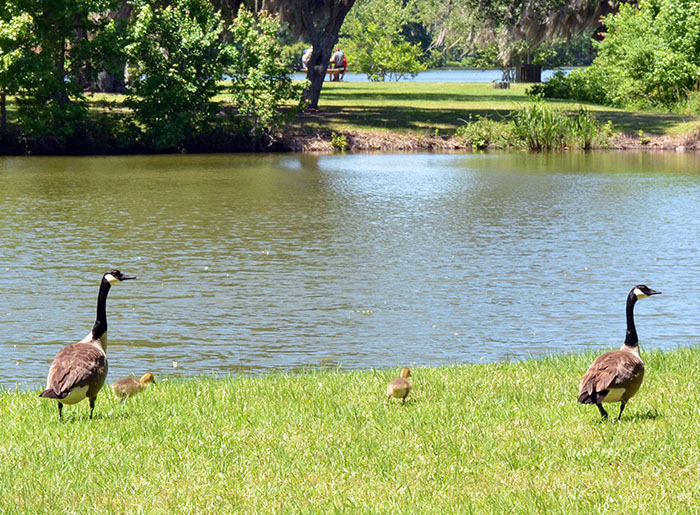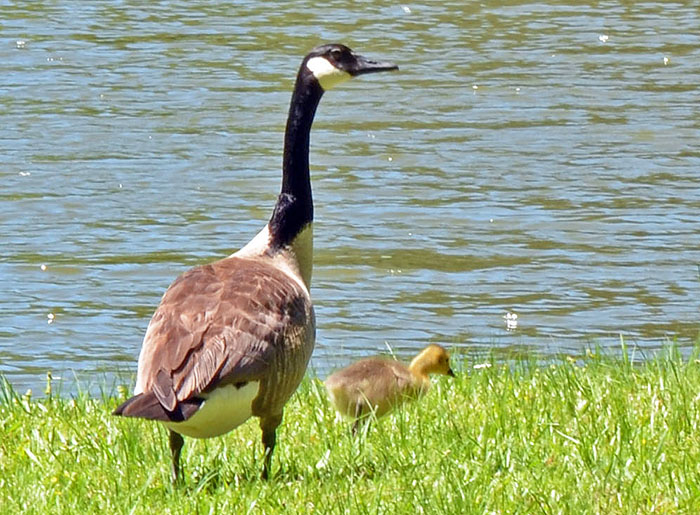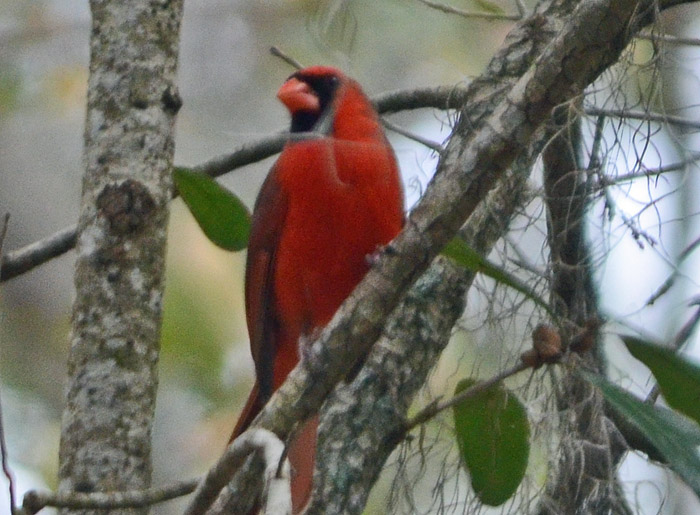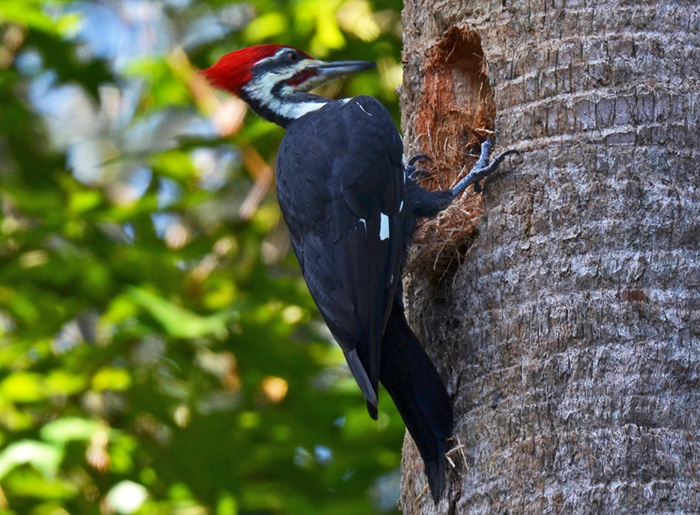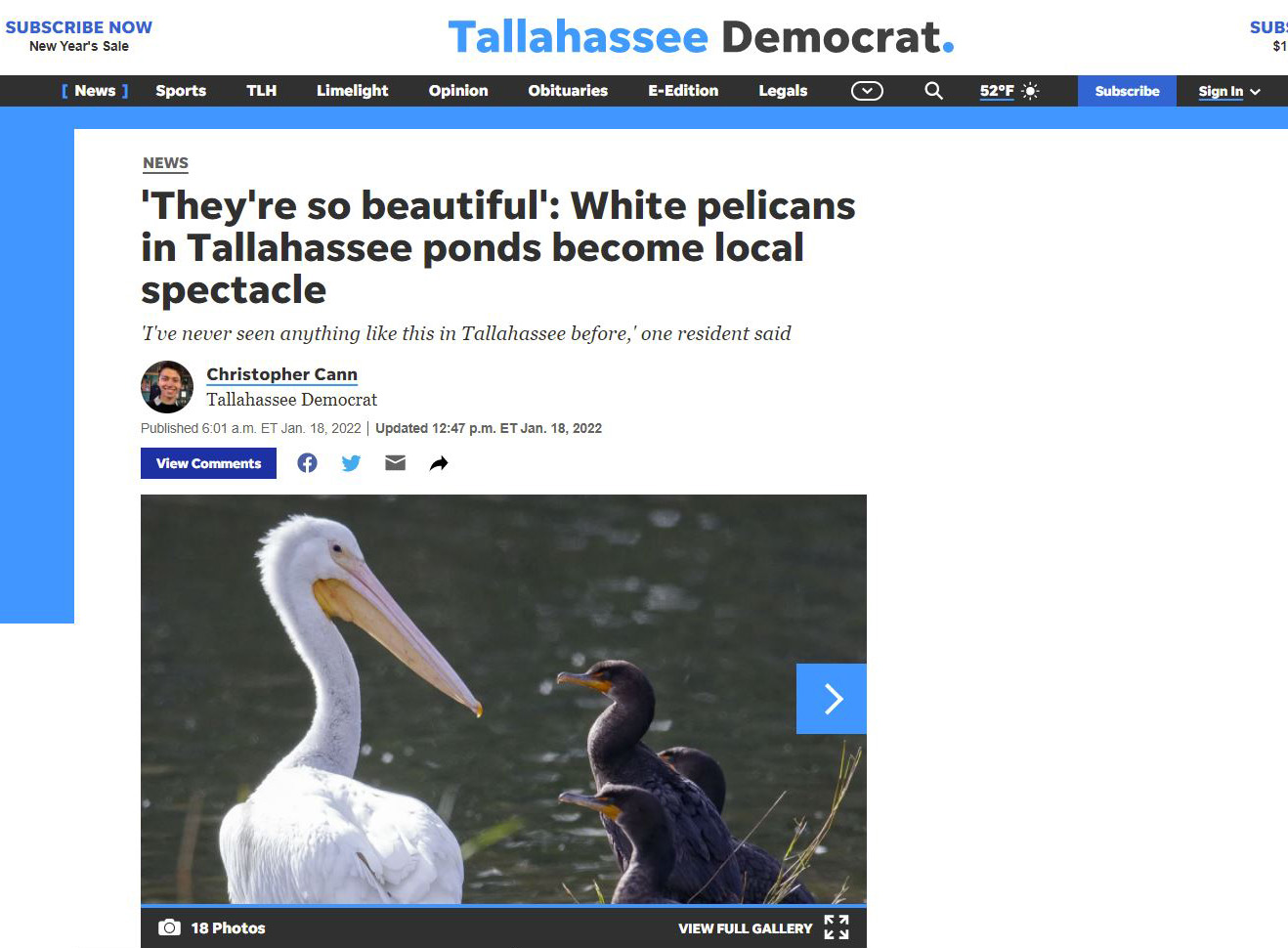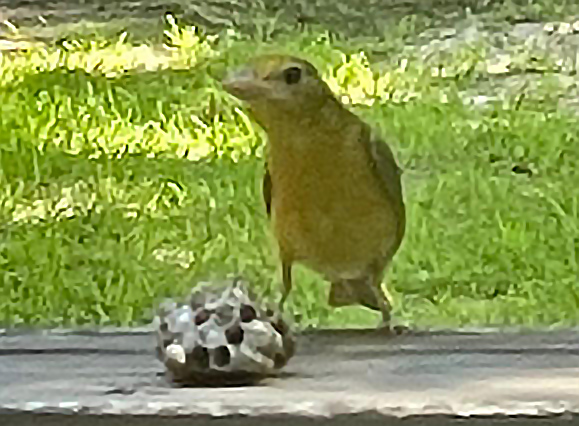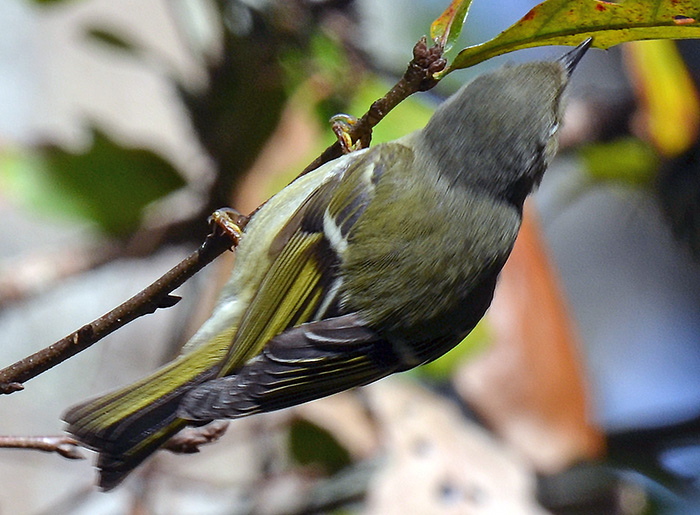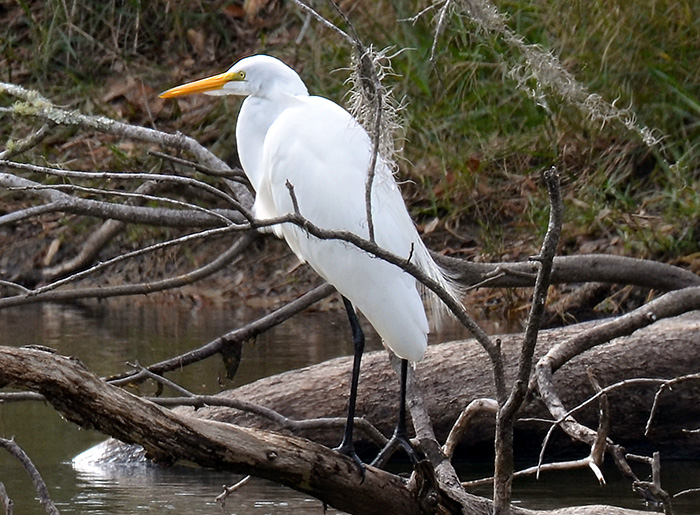 Ardea alba (Great Egret). | The first photo of 2018 and the first one with my new Nikon 200-500mm f/5.6 lens. I have seen this big, white bird essentially every day for the past month and that dead branch is its favorite fishing spot. I disclose that it is not strictly within my yard but just across our small dock ... the excitement over the new lens is just too big. Great white egrets feed in shallow water mainly on fish, frogs, small mammals, and occasionally insects and reptiles. They spear their prey with their long, sharp bill, typically by standing still and allowing the prey to come within striking distance.
Click here for a higher resolution version of this photo. wikipedia: https://en.wikipedia.org/wiki/Great_egret floridanature.org: http://www.floridanature.org/species.asp?species=Ardea_alba | ||
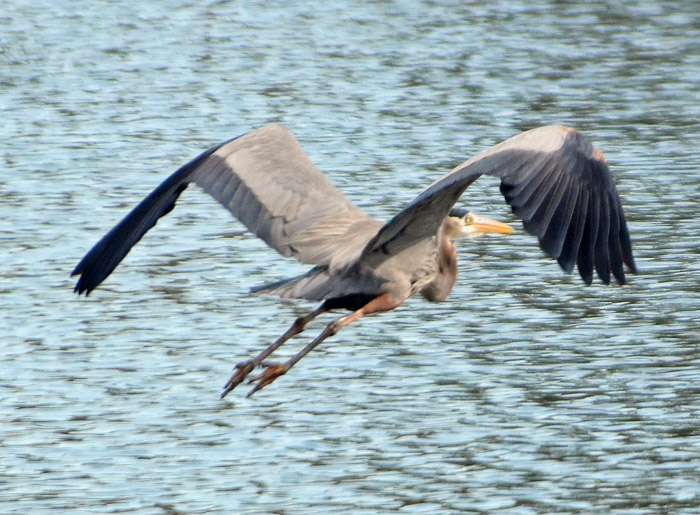 Ardea herodias (Great blue heron). | These could be great blue herons but I need to verify this. Great blue herons appear blue-gray from a distance, with a wide black stripe over the eye. In flight, the upper side of the wing is pale on the forewing and darker on the flight feathers. They wade slowly or stand statue-like, stalking fish and other prey in shallow water or open fields. The small photo was taken on 05/23/18.
wikipedia: http://en.wikipedia.org/wiki/Great_blue_heron | ||
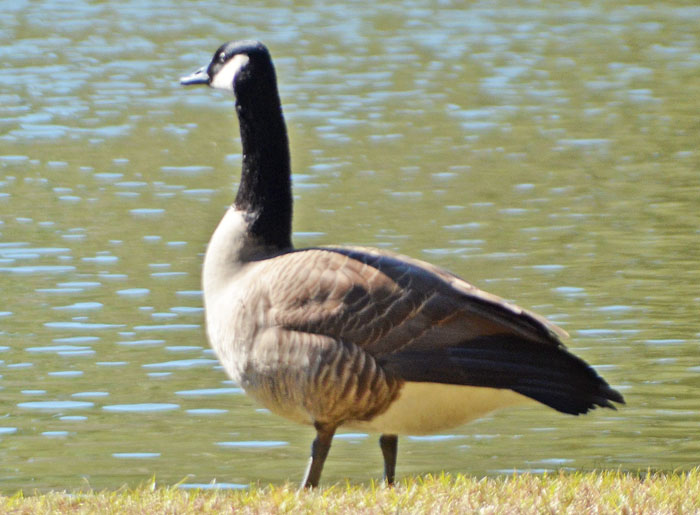 Branta canadensis (Canada Goose). | A bunch of Canada Geese stopped at our lake today. They are large, have a black head and neck, white patches on the face, and a brown body ... and very strong nerves. They are long-lived and some individuals reach an age of 30 years. I took the small photo on 05/06/17.
wikipedia: http://en.wikipedia.org/wiki/Canada_goose UF: http://edis.ifas.ufl.edu/uw245 | ||
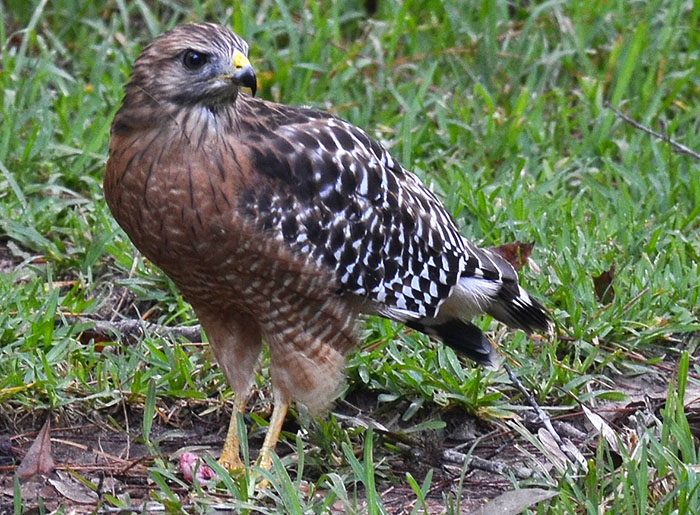 Buteo lineatus (Red-shouldered Hawk). | This hawk is Buteo lineatus. Citing from the second link: "A hawk of the woodlands, often heard before it is seen. The clear whistled calls of this hawk are conspicuous, especially in spring; in the east, Blue Jays often give a near-perfect imitation of this call. Over much of eastern North America the Red-shoulder has become uncommon, sticking closely to the remaining forests. Populations in Florida and California are often more visible, perhaps adapting better to open habitats." They usually hunt by watching from a perch and feed on small mammals, amphibians, reptiles, birds, occasionally fish, and rarely carrion.
wikipedia: https://en.wikipedia.org/wiki/Red-shouldered_hawk Audubon Field Guide: http://www.audubon.org/field-guide/bird/red-shouldered-hawk | ||
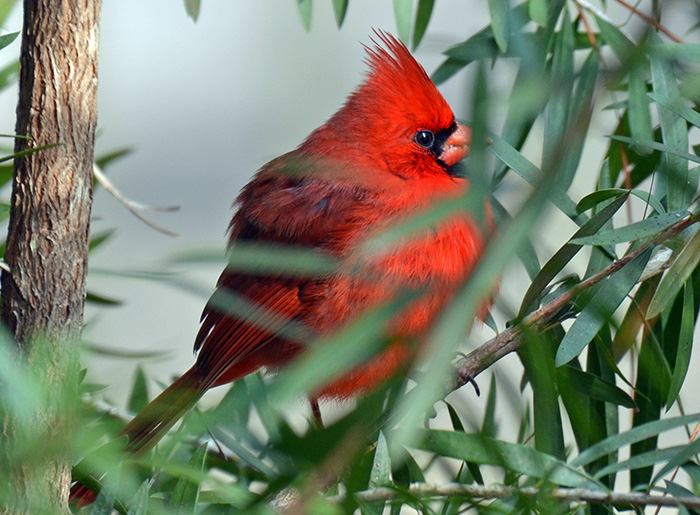 Cardinalis cardinalis (Northern Cardinal) ♂. | This striking little neighbor is the Cardinal. During courtship, the male feeds the female. Wikipedia states that this bird was once prized as a prized pet species but its sale as a cage bird has been banned for nearly 100 years. Cardinals are extremely territorial and can relentlessly attack their mirror images in windows.
wikipedia: http://en.wikipedia.org/wiki/Northern_cardinal Cornell: http://www.allaboutbirds.org/guide/Northern_Cardinal/id | ||
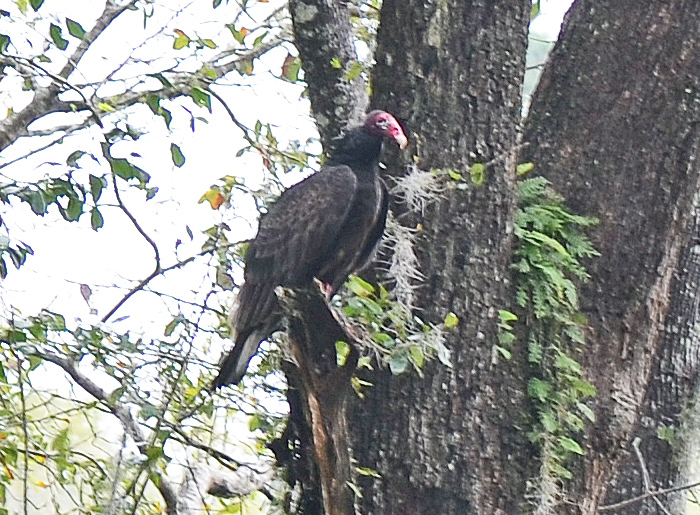 Cathartes aura (Turkey Vulture). | Florida is home to two vulture species: the turkey vulture (Cathartes aura, red head) and the black vulture (C. atratus, black head). They lay their eggs on the ground under cover (e.g. palmetto thickets), in hollow tree trunks, or caves. No nests are built for the usually two eggs. Vultures eat carrion in the form of road-kills or dead cattle. Black vultures are more aggressive and may occasionally kill or injure small or weak livestock. Vultures are under state protection. Florida Fish and Wildlife Conservation Commission: http://myfwc.com/wildlifehabitats/profiles/birds/raptors-and-vultures/vultures/ wikipedia: https://en.wikipedia.org/wiki/Turkey_vulture | ||
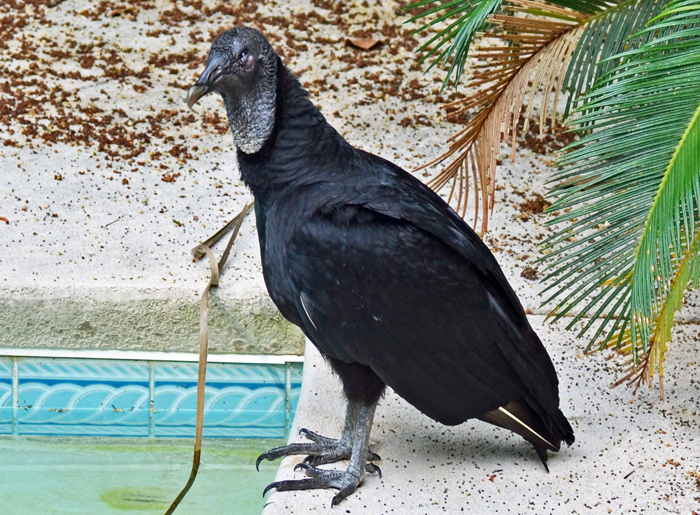 Cathartes atratus (Black Vulture). | Florida is home to two vulture species: the turkey vulture (Cathartes aura, red head) and the black vulture (C. atratus, black head). They lay their eggs on the ground under cover (e.g. palmetto thickets), in hollow tree trunks, or caves. No nests are built for the usually two eggs. Vultures eat carrion in the form of road-kills or dead cattle. Black vultures are more aggressive and may occasionally kill or injure small or weak livestock. Vultures are under state protection. Florida Fish and Wildlife Conservation Commission: http://myfwc.com/wildlifehabitats/profiles/birds/raptors-and-vultures/vultures/ | ||
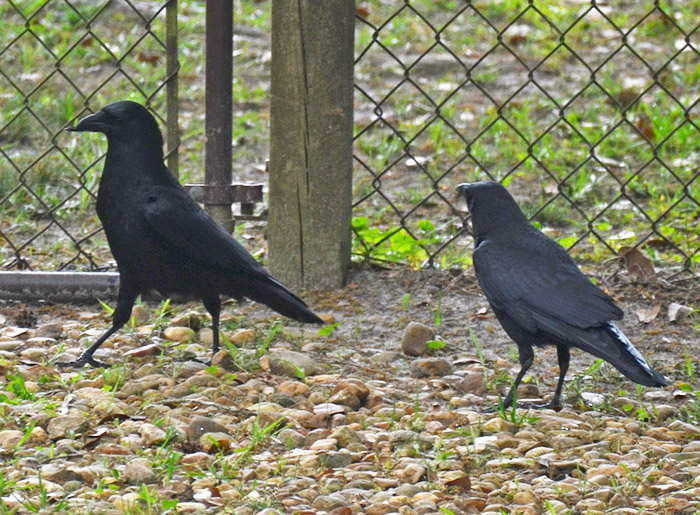 Corvus sp. (Crow). | Yes, the continental US is actually home to three different crow species: the American, the Fish, and the Northwestern Crow. These birds are either American or Fish Crows, which are best distinguished by their calls (but not by me). If you are curious follow the first link which offers short sound clips. Also interesting: crows are intelligent and the oldest documented captive crow died at age 59.
audobon: http://www.audubon.org/news/birdist-rule-65-how-tell-difference-between-crows wikipedia: https://en.wikipedia.org/wiki/Corvus | ||
 Cyanocitta cristata (Blue Jay). | This birdie looks a bit tired and doesn't show its pretty crown of feathers. It was early in the morning and perhaps it had rained. Anyway I shot this picture through the small window of our guest bathroom, which allowed me to get pretty close.
Blue jay (Cyanocitta cristata). These birds are rather loud and can imitate other birds (hawks) as well as human voices (this one didn't). wikipedia: http://en.wikipedia.org/wiki/Blue_jay | ||
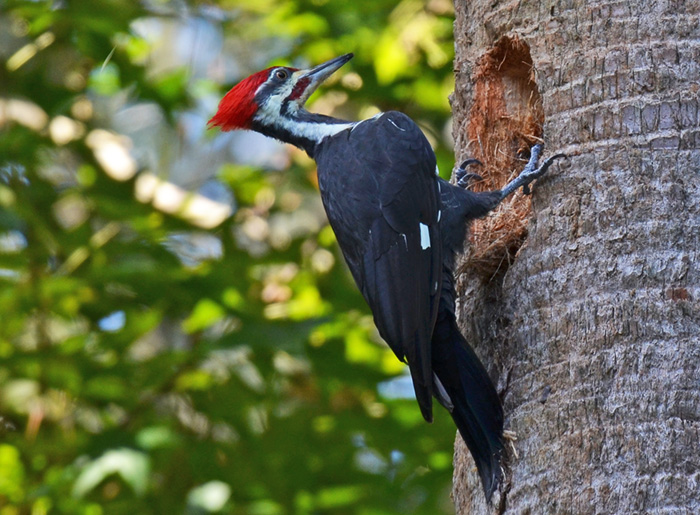 Dryocopus pileatus (Pileated Woodpecker). | I caught this beautiful wood pecker on our tall palm tree. Pileated woodpeckers mainly eat insects, especially carpenter ants and wood-boring beetle larvae, but also fruits, nuts, and berries. They excavate their large nests in dead trees, which can cause smaller trees to break in half. Pileated woodpecker pairs stay together on their territory all year round.
wikipedia: https://en.wikipedia.org/wiki/Pileated_woodpecker | ||
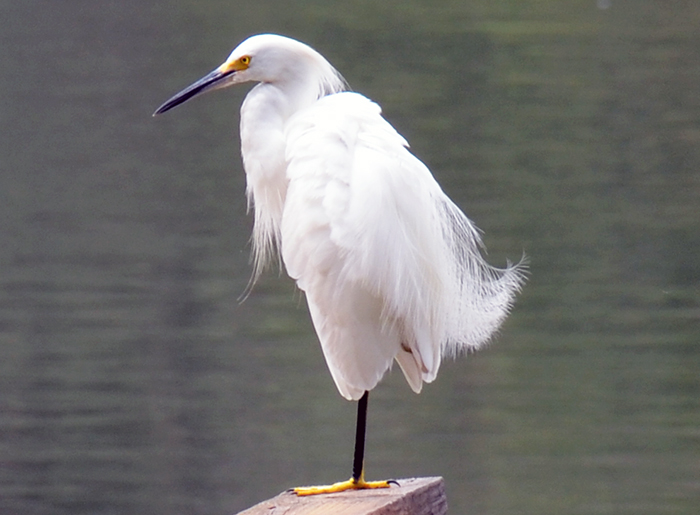 Egretta thula (Snowy Egret). | Black bill, black legs, and yellow feet ... a snowy egret resting on our little dock. In the old days, the beautiful white plumes of this bird were in great demand as decorations for women's hats, which reduced their numbers to dangerously low levels. Now protected by US law, the population has rebounded. Snowy egret eat mostly aquatic animals, including fish, frogs, worms, crustaceans, and insects. wikipedia: https://en.wikipedia.org/wiki/Snowy_egret | ||
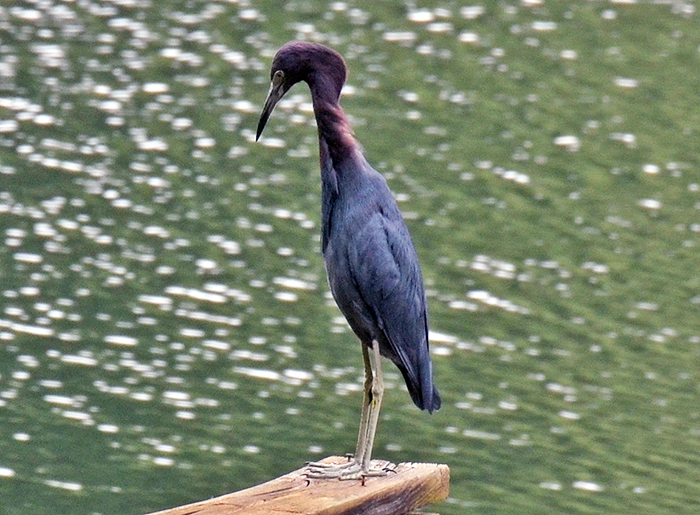 Egretta caerulea (Little Blue Heron). | Breeding adults of Egretta caerulea have blue-grey plumage except for the head and neck, which are purplish and have long blue filamentous plumes. The legs and feet are dark blue. The sexes are similar. Non-breeding adults have dark blue head and neck plumage and paler legs. Young birds are all white except for dark wing tips and have dull greenish legs. These white little blue herons often mingle with snowy egrets. wikipedia: https://en.wikipedia.org/wiki/Little_blue_heron Cornell Lab of Ornithology: https://www.allaboutbirds.org/guide/Little_Blue_Heron | ||
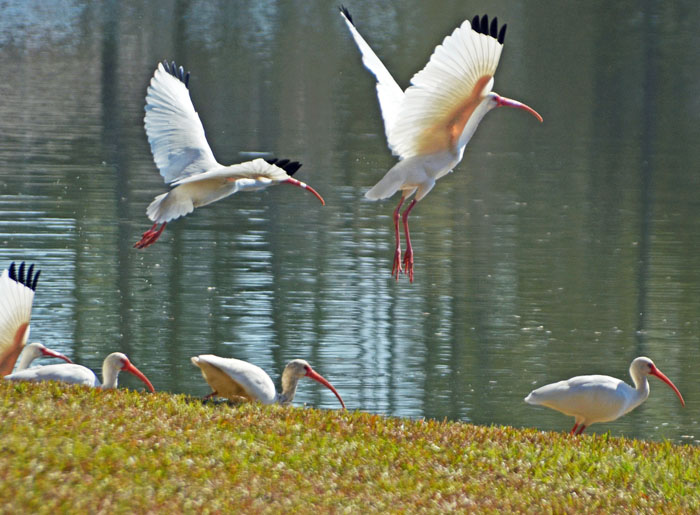 Eudocimus albus (American White Ibis). | Today a group of about a dozen white ibis visited us. I also saw at least one darker juvenile bird. Wikipedia states that according to Native American folklore "the bird was the last to seek shelter before a hurricane, and the first to emerge afterwards. The bird was thus a symbol for danger and optimism." These photos were taken with a Sigma 28-300 mm zoom lens. Click here for a high resolution of the left photo.
wikipedia: http://en.wikipedia.org/wiki/American_white_ibis | ||
 Megaceryle alcyon (Belted Kingfisher). | Perching on a post that once held a nice birdhouse is this belted kingfisher Megaceryle alcyon. This species is a stocky, medium-sized bird and nests in a horizontal tunnel made in river banks or similar sand banks. I will definitely try to get some better pictures soon. wikipedia: https://en.wikipedia.org/wiki/Belted_kingfisher Audubon: http://www.audubon.org/field-guide/bird/belted-kingfisher | ||
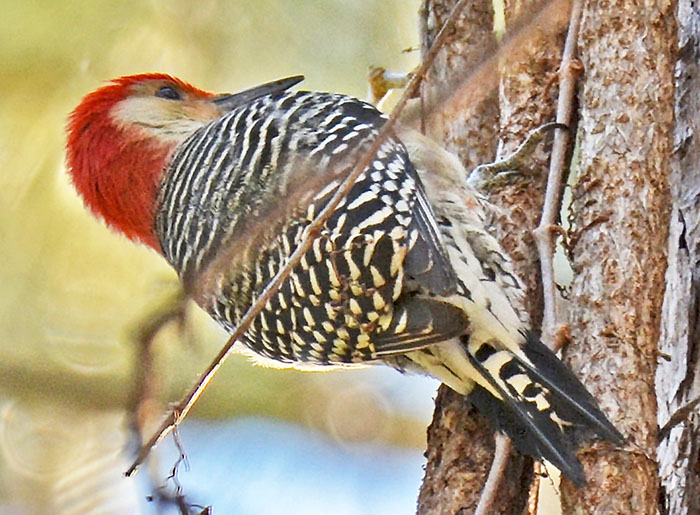 Melanerpes carolinus (Red-bellied Woodpecker) ♂. | The name red-bellied woodpecker is misleading because the red plumage is on the head. It is closely related to the red-headed woodpecker which looks quite different. They are noisy birds and their calls have been described as sounding like churr-churr-churr or thrraa-thrraa-thrraa with an alternating br-r-r-r-t sound. Males tend to call and drum more frequently than females. The drums consist of six taps and are meant to attract mates. They drum on hollow trees and even on aluminum roofs and transformer boxes.
wikipedia: https://en.wikipedia.org/wiki/Red-bellied_woodpecker | ||
 Mimus polyglottos (Northern Mockingbird). | The ubiquitous northern mocking bird (Mimus polyglottos). It is the state bird of Florida.
Mocking birds are very territorial and rule our yard (as far as birds are concerned). They like to attack and chase other birds even crows etc. They have a large repertoire of songs (including many "imitations") which tend to be short and repetitive. wikipedia: http://en.wikipedia.org/wiki/Northern_Mockingbird | ||
 Mycteria americana (Wood Stork). | Every February, a group of wood storks visits our lake. They sometimes hang out with some white ibises that we see more frequently. Until 2014, wood storks in the US were considered an endangered species but--after decades of conservation efforts--have been reclassified as only threatened. They are the only stork species that breeds in North America with small populations in Florida, Georgia, and the Carolinas. wikipedia: https://en.wikipedia.org/wiki/Wood_stork | ||
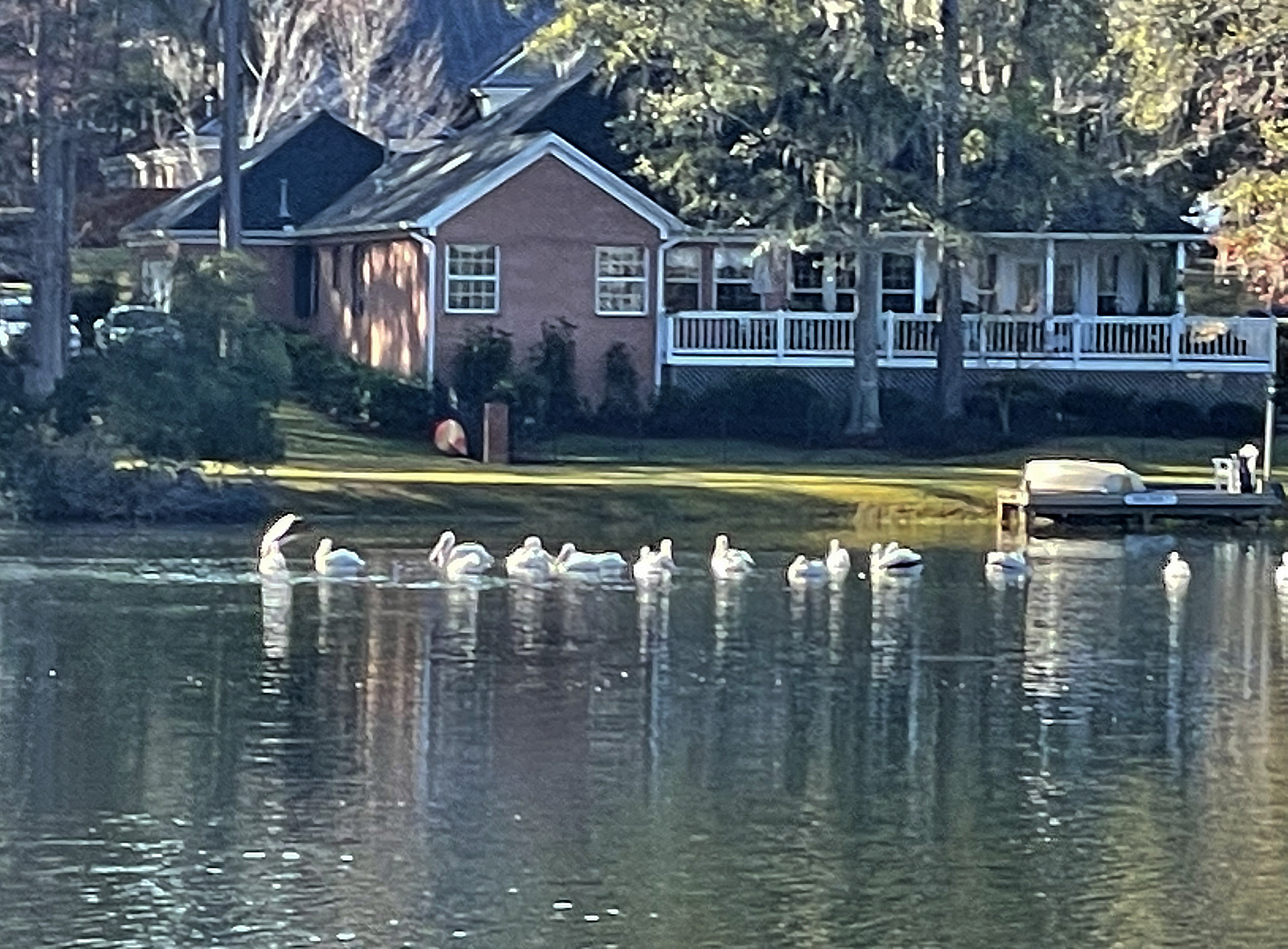 Pelecanus erythrorhynchos (American White Pelican). | Sorry ... a terrible iPhone photo. Those pelicans were close to our dock when I first saw them, but had sailed to the other side of the little lake when I finally arrived to take a picture. This was my first sighting of them here and seemingly they are uncommon in Tallahassee as noted in a recent article in our local newpaper. I hope that they'll be back soon.
Wikipedia: https://en.wikipedia.org/wiki/American_white_pelican Tallahassee Democrat (01/18/22): https://tinyurl.com/dsb6xhkw | ||
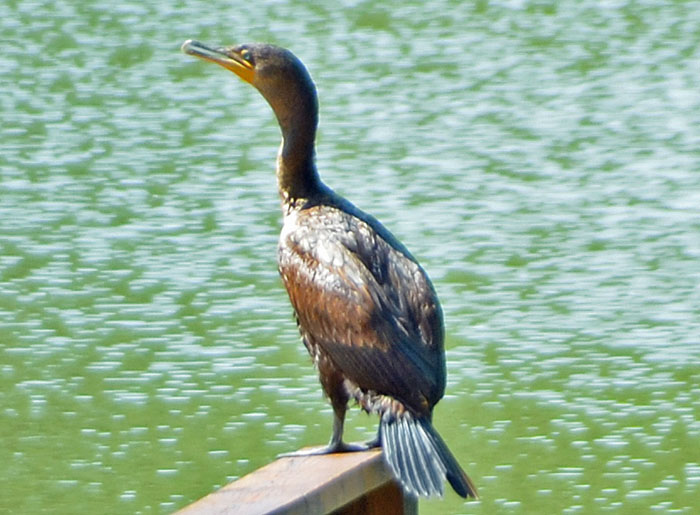 Phalacrocorax sp. (Cormorant). | This cormorant dried its wings on our little dock. Unlike the similar anhinga, it has a curved beak. I am guessing that this is a juvenile double-crested cormorant (Phalacrocorax auritus). wikipedia: http://en.wikipedia.org/wiki/Cormorant | ||
 Piranga rubra (Southern Tanager). | I spotted a small bird pecking at a wasp nest on our upper window. About an hour later, it had removed the entire nest and perched on the rail, giving me a chance to snap a few photos before flying off with its prize. Southern tanagers spend their summers in the southern US and migrate to Mexico, Central America, and northern South America for the winter. These birds are bee and wasp specialists, catching their prey in mid-air and killing them by beating them against a branch. Before eating a bee, they cleverly rub it on the branch to remove the stinger.
wikipedia: https://en.wikipedia.org/wiki/Summer_tanager | ||
 Regulus calendula (Ruby-crowned Kinglet). | Males and females look identical but males have a red crown patch, which is usually concealed but raised when the bird is agitated. Also the juveniles are similar in plumage. They fearlessly defend their nests and often perform a "broken-wing" act to draw predators away. They do not make a good target for the photographer as they appear to be very active.
audobon: http://www.audubon.org/field-guide/bird/ruby-crowned-kinglet wikipedia: https://en.wikipedia.org/wiki/Ruby-crowned_kinglet | ||
 Setophaga americana (Northern Parula). | The Northern Parula is a small and relatively common bird in the eastern half of the country, but this is the first time I've spotted it around our house. It has mainly blue-gray upper parts, with a greenish back patch and two white wing bars. The breast is yellowish, shading into the white belly. The summer male features bluish and rufous breast bands, along with prominent white eye crescents, making it a distinctive sight. The Northern Parula often weaves its nest in hanging Spanish moss or beard lichen, often suspending it over water for added protection from predators.
wikipedia: https://en.wikipedia.org/wiki/Northern_parula | ||
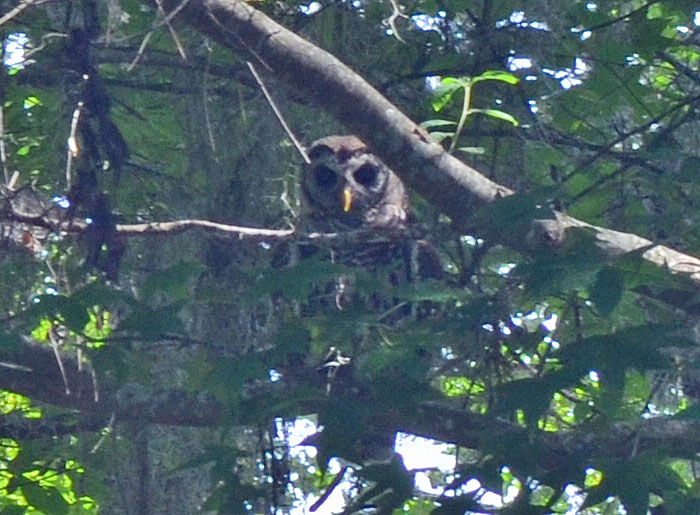 Strix varia (Barred Owl). | Okay, it's an awful photo but this owl simply must be featured here. It essentially lives on our property but is hard to spot and even harder to photograph. However, it is quite easy to distinguish its call which sounds like "who cooks for you, who cooks for you all." wikipedia: https://en.wikipedia.org/wiki/Barred_owl learner.org (call): http://learner.org/jnorth/sounds/Owl_Barred_WhoCooks.mp3 | ||
 Thryothorus ludovicianus (Carolina Wren). | Rather loud for such a small bird and again difficult to get a good photo. Wikipedia states that "Carolina wrens are wary, and are more often heard than seen." They have a song repertoire of at least 20 different phrase patterns and on average, 32. Males can increase their repertoire by learning, but the song learning must occur within the first three months of life. Our Florida version of this bird is larger and stouter than those up north, a darker rusty chestnut above and more deeply colored below.
wikipedia: https://en.wikipedia.org/wiki/Carolina_wren Audubon: https://www.allaboutbirds.org/guide/Carolina_Wren | ||
 Toxostoma rufum (Brown Thrasher). | Another common bird in our yard is the brown thrasher (Toxostoma rufum). It belongs to the same family (Mimidae) as the mocking bird. It seems to spend a lot of time on the ground inspecting the edges of our lawn where leaves accumulate.
Like the mocking bird, it is a prolific "singer". According to wikipedia, brown thrashers know up to 3,000 songs (sounds like they are improvising). The brown thrasher is the state bird of Georgia. wikipedia: http://en.wikipedia.org/wiki/Brown_Thrasher |


